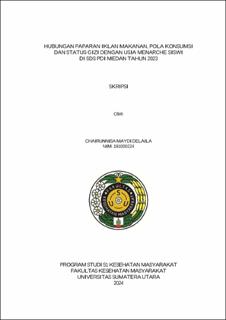| dc.contributor.advisor | Sanusi, Sri Rahayu | |
| dc.contributor.author | Delaila, Chairunnisa Maydi | |
| dc.date.accessioned | 2024-08-02T07:24:00Z | |
| dc.date.available | 2024-08-02T07:24:00Z | |
| dc.date.issued | 2024 | |
| dc.identifier.uri | https://repositori.usu.ac.id/handle/123456789/94719 | |
| dc.description.abstract | Digital media is now an unavoidable part of everyday life, especially for generations who are up-to-date on issues spread across mass media and the internet. The exposure of the latest advertisement of junkfood is easily spread in various media so that it affects children's eating decisions within a short time after seeing the advertisement. This creates concerns regarding the negative effects on consumption patterns and nutritional status of children. Excessive consumption of animal protein, fat, and sugar can affect the nutritional status of children due to buildup of fat and increased hormone, leading to early puberty in girls. The decline in menarche's early age can affect faster physical and emotional growth in young women, putting additional social pressure and increasing the risk of future health problems. The purpose of this study is to find out the relationship between food advertising, consumption patterns, nutritional status exposure and early menarche age at the Medan PDI private elementary school. The research design used was cross sectional with 63 students who had menstruated with Jumlah sampling technique. The data was obtained by filling out the food advertisement exposure questionnaire form, consumption pattern, nutritional status with weight and height measurements. Based on research results, 92.1% were exposed to food advertising, 54% for incomplete consumption patterns, 22% for poor nutritional status and 30.2% for early menarche. Analysis of the chi-square test, then the result obtained by p>0.05 is that there is no significant relationship between food advertising exposure and menarche age (p=0.311). Other results obtained consumption patterns (p=0.017), consumption patterns with nutritional status (p=0.000), and consumption patterns (p=0.004), nutritional status (p=0.000) with menarche age (p=0.000) which means that there is a significant relationship between variables in SD PDI Medan. Therefore, the suggestion for this study is expected so that students can maintain the pattern of food consumption so that nutritional status is in good condition so that it can prevent experiencing early menarche. | en_US |
| dc.language.iso | id | en_US |
| dc.publisher | Universitas Sumatera Utara | en_US |
| dc.subject | Adolescents | en_US |
| dc.subject | advertising | en_US |
| dc.subject | nutritional status and menarche | en_US |
| dc.subject | SDGs | en_US |
| dc.title | Hubungan Paparan Iklan Makanan, Pola Konsumsi dan Status Gizi dengan Usia Menarche Siswi di SDS PDI Medan Tahun 2023 | en_US |
| dc.title.alternative | Relationship of Exposure to Food Advertising, Consumption Patterns, and Nutritional Status with Menarche Age at Medan SDS PDI in 2023 | en_US |
| dc.type | Thesis | en_US |
| dc.identifier.nim | NIM191000224 | |
| dc.identifier.nidn | NIDN0025127102 | |
| dc.identifier.kodeprodi | KODEPRODI13201#Kesehatan Masyarakat | |
| dc.description.pages | 130 Pages | en_US |
| dc.description.type | Skripsi Sarjana | en_US |


